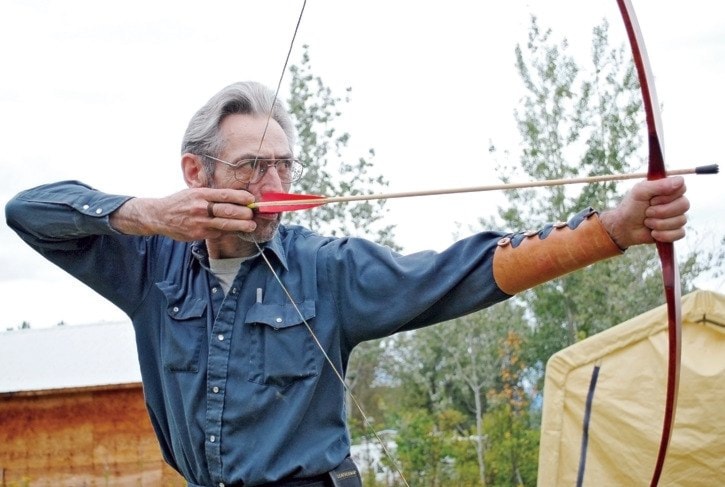Rob Widen takes an unfinished bow off his workbench, strings it, and slowly draws it over a long block of wood he has notched to measure how much weight the string bears.
The trick to making a wooden bow is to shape it so that it shoots fast, packs light and stays strong—a task that takes a careful balance of forces.
“When you’re working with wood you have to let the wood tell you exactly where to go,” Widen says. “And when it really tells you where to go it usually says ‘crack’.”
When an archer draws a bow, the inner face or “belly” of the bow compresses at the same time that the outer faces is stretching. Bow makers have to anticipate just how the type of wood they choose will stretch and bend.
In the Bulkley Valley, Widen usually starts with a birch or maple tree, though this winter he also plans to cut bows from his first pieces of yew and wild apple.
After he splits or quarters the wood into six-foot wedges, Widen cuts the bow into different designs—he prefers bows with slightly wider faces that bend to a nearly circular curve.
In the last few years, he said, bow markers discovered that thin-tipped bows shoot much faster. To get the tips right, he uses a scraper that can peel off a thousandth of an inch of wood at a time.
Widen also makes his own wooden arrows. He rounds out a dowel, trims it with a point and feathers, and grades each shaft by tensile strength—with wood, he said, it’s important to match the arrow’s strength to the draw weight of the bow.
Kids’ bows start at a draw weight of 20 pounds or so. Hunting bows can stand 60 pounds of tension or higher.
Men tend to want those heavyweight bows, Widen said.
“It’s mostly a macho thing. Women aren’t half so bad with this—they’ll pull a bow they can handle and be happy with it.
But a guy will look at a heavyweight bow and say ‘I can handle that,’ he said, laughing. He used to do it himself, he said, but has since got over it.
The thing is, Widen said, a guy usually can handle a heavyweight bow—at least for the first 20 shots.
But his arm will tire at a day-long archery shoot, worsening his aim.
And on a hunting trip, Widen said, aim really matters.
“You have absolutely no business letting go of the arrow if you don’t know you’re going to hit the animal in the right spot,” he said.
Generally speaking, bow hunters don’t get a second chance to shoot a wounded animal, he added.
Pope and Young, the Californians who helped make bow hunting a popular sport in the 1920s, liked to claim that a 40-pound bow could kill any animal in North America.
Widen thinks that’s stretching it a bit, but said he generally likes to hunt with a mid-weight bow.
While rifle hunters can take aim by lining up the two sights on their guns, Widen makes his bows without sights. The archer aims by simply lining up his or her bow hand and arrow hand.
Good aim comes more easily if you can get at least one hand in the same spot each shot, Widen said. He draws his arrow hand back so that his middle finger just reaches the corner of his mouth.
When it works, he said, you don’t think about it. Just like pitching a rock, archers get an instinctive sense for the right time to let go.
Widen goes bow-hunting nearly every year on the Haida Gwaii, coming home to Telkwa with many deer and a black bear.
The islands are beautiful, he said, and the only place in the area that has a deer season in mid-winter.
“The secret in bow hunting is not how far can you shoot an animal from,” he said, “It’s to get close enough that you can’t miss.”
Widen said he knows for sure that he can hit a deer at 30 yards. But to hit it just where he wants to, he like to be less than 20 or even 15 yards away.
That takes stealth or patience, he said, adding that he doesn’t have much of the latter.
Widen said he doesn’t believe in wearing camouflage, preferring to just stalk quietly and keep a wide tree or big rock between him and his target.
From his home in Telkwa, Widen offers weekend bow-making workshops.
He also makes custom-fit bows, though he recommends that beginners borrow one for a thousand shots or so until they get a feeling for what draw weight they would like to shoot.
